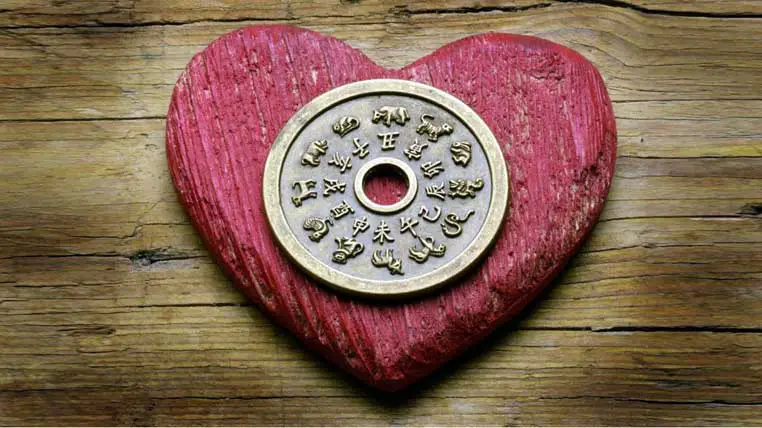To understand Chinese astrology, it is essential to first grasp the basis of Chinese philosophy regarding the world, which is fundamentally different from that perceived by Western eyes.
And, with a better understanding of some of China’s most important concepts about life and death, we can also understand the 12 animal-focused cycles of Chinese astrology.
The Fascinating Yin and Yang Principles
Before discussing Chinese astrology, we first need to understand the concepts of Yin and Yang.
At the foundation of all things is Dao, which can be translated as “path” and represents the universe in its perpetual motion.
From Dao emanates taiyi, or “Great One,” the first principle, which is expressed through taiji, or “Supreme Summit.” In the “Supreme Summit” we find the first manifestation of Yin and Yang.
Yin symbolizes the moon, femininity, darkness, coldness, and hiddenness, while Yang represents the sun, masculinity, brightness, and warmth.
Yin and Yang complement each other and are the principles upon which Chinese mythology explains the universe’s formation.
Another classification system is added to this dualist principle: the five primordial elements, which can also be translated as the “Five Agents.” These primordial elements are Wood, Fire, Earth, Metal, and Water.
With this system, the parts that form the universe and nature can be classified into groups of five, such as five cardinal elements, five seasons, five planets, five colors, five musical notes, five scents, and five tastes.
In this framework, the human being is part of universal harmony, a microcosm in the macrocosm.
The best illustration of this spirit is the Daoist principle of wu wei, or “non-action.” This does not mean remaining passive but knowing how to be active without opposing the universal order.
A Daoist philosopher falling into a torrent and surviving only by letting themselves be carried by the waves without struggling is an excellent example of this principle.
Thus, Chinese astrology principles are grounded in this fundamental universe understanding.
Not only are there different methods for Chinese astrology, but also different states of mind.
In Chinese astrology, one can only speak of “astrology” when one can know one’s destiny by consulting a daily lunar calendar with few considerations about the stars and more of a cyclical system of characters.
The Sun and the Moon are present in the form of Yang and Yin, while the planets (Jupiter, Mercury, Mars, etc.) are scarcely used today, whereas their use in antiquity was primordial.
Furthermore, the term “astrology” is improper when denoting observations or astronomical calculations since, in ancient China, the margin between these two sciences is sometimes thin or even nonexistent.
Notably, prominent astronomers such as Newton and Kepler in the West practiced astrological techniques with the utmost seriousness.
If we put Chinese astrology in parallel with Western astrology, it is much harder to talk about “astrology.” Instead, the most fitting word would be “horoscope.”
The Art of Divination Through Planets
All Chinese divinatory sciences show the connections between divination and cosmological representations.
When a turtle shell cracked due to the heat of the ember, it not only revealed the hazard or future of an augur but also allowed the augur to determine what was better or worse to do at a specific moment or in a particular place, on a certain subject, with the king as the mediator between heaven, earth, and men.
When the diviner skillfully handled the rods of the mouse tail, he appealed to the hexagrams formed by the eight trigrams representing the entire universe.
Divination was so essential and well integrated into daily human activities that no religious rite or ceremony was conducted without it.
After considering all of this, what place should we give to astrology? It would be complicated to determine the date from which the stars have been used to predict the future.
The first complete panorama of Chinese astrology and astronomy was constructed by Sima Qian (146-86 BC), a scholar belonging to the imperial court of the Early Han Dynasty (206-8 BC). Sima Qian, considered the first historian of China, was also an astrologer.
In his work “Shiji” (eng. “Historical Memoirs”), he wrote the history of his country from its origins, dealing with the calendar as well as the planets.
Whether it was the North Star, the twenty-eight Houses (or constellations), the Moon, the Sun, or the Five Planets, all played essential roles in astrology.
The position, movement (either in a straight line or in a zig-zag, retrograde), rising and setting, and color were all carefully observed and listed.
Additionally, many predictions related to everyday life, state affairs, and agricultural works were also found.
In addition to the Sun and Moon, whose central role is that of a symbol (the masculine and feminine principle), Sima Qian also emphasizes the Five Planets: Jupiter, Mercury, Mars, Saturn, and Venus.
Qian was one of many historians interested in the astral sciences.
Liu An, Prince of Huainan (died in 122 BC), left us a work of Daoist inspiration, “Huainanzi,” in which he deals with some aspects of astronomy and astrology. In fact, Sima Qian was inspired by this writing.
To these writings, we can also add a recently discovered text at Mawangdui, an archaeological site four kilometers from Changsha, the current capital of the Hunan province.
A silk manuscript, titled “Divination with the Help of the Five Planets,” was discovered inside a tomb from the Early Han Dynasty.
After studying it, the archeologists concluded the manuscript used similar ideas and concepts as a much older text, the “Star Manual,” written by two Chinese astronomers, Shishen and Gande, sometime between 453 and 222 BCE, towards the end of the Zhou Dynasty.
Although many of the astrology treatises have been lost, the ones that have survived are enough for us to comprehend the spirit of Chinese astrology, which has endured for centuries and is still very much alive today.
Origins of the Chinese Zodiac
The Chinese zodiac is based on the Chinese calendar. Still, the twelve zodiac signs of Chinese astrology differ from those of Western astrology, and their symbolism is also different.
Unlike the Western zodiac, which is divided into twelve months, the Chinese zodiac is divided into twelve years.
The Chinese horoscope is said to have been adopted in Japan in 604, during the reign of Empress Suiko. Still, its origin is quite challenging to trace.
In ancient China, each year was named after an animal: Rat, Ox, Tiger, Rabbit, Dragon, Snake, Horse, Goat, Monkey, Rooster, Dog, and Boar. The twelve zodiac signs of the Chinese zodiac rotate every twelve years.
According to Chinese legends, on New Year’s Day, Buddha summoned all the animals, but only twelve showed up, demonstrating their devotion to him.
Buddha named the years after them as a reward, in the order in which they arrived.
Gustaaf Schlegel (1840-1903), an expert in ancient Chinese culture and history, noted that in the early ages, an asterism was named for each event of the year.
Later, more reliable methods were invented to calculate the periods of the year, and the ecliptic was divided into twelve equal parts, which were given the names of the twelve animals.
Six of these animals (ox, rooster, dog, sheep, horse, and pig) were destined for sacrifices. At the same time, the other six referred to the natural events that they announced.
The Symbolism of the 12 Months of the Chinese Zodiac
As said before, Chinese astrology is quite unique. The Chinese zodiac is a system that assigns an animal to each year in a twelve-year cycle.
Each of these twelve animals has its own symbolic significance, which can be used to better understand how the Chinese agricultural rhythm has been perceived over the years.
Nowadays, the Chinese zodiac is no longer used monthly but annually. Therefore, a person’s birth year determines the sign under which they were born.
That’s one of the reasons why in China, if someone wants to know your age, they will ask about your zodiac sign rather than the year you were born.
Now, let’s take a closer look at the symbolism of each month in the Chinese zodiac.
February: The Snake
In Chinese astrology, February is the first month of spring. The Snake announces the beginning of spring as the snakes come out of their hiding places, indicating the arrival of the new season.
March: The Dragon
The Dragon announces the second month, corresponding to the spring equinox in March. Like the Libra, the dragon symbolizes the equality of days and nights.
April: The Rabbit
The third month is announced by the Rabbit. In April, does give birth to their kits, and peasants fear for their crops.
May: The Tiger
The Sun enters the Tiger in May. The tiger is a solar animal, the prince of the mountains. Its position in the first month of summer perfectly matches its symbol.
June: The Black Bull
In the fifth month (the summer solstice, June), a black bull is sacrificed when the heat is at its highest. This sacrifice, directed north, is dedicated to the Earth as Yin is slowly reborn.
July: The Rat
In July, in the sixth month, the cereals and the rice reached maturity, and the culmination of the constellation of the Rat in the sky reminded the peasants of the arrival of the rodents on the fields.
August: The Boar
In Chinese astrology, the seventh month corresponds to the Boar. In August, the peasants allowed pigs to roam the fields, looking for food roots, and they prepared the soil for plowing.
In addition, the sacrifice of a pig took place on the day the peasants brought the emperor his harvest.
September: The Dog
The eighth month of the Chinese year is also the first month of autumn, the period of capital executions and punishments.
In the Temple of Ancestors, the emperor sacrificed a dog to call the breath of autumn and to prevent the Earth from being devastated by the winds, drought, humidity, or harmful animals.
October: The Rooster
The ninth month (October) was the period for preparing for war. The rooster, known for being a warrior, embodies the male, the soldier, a fitting symbol for this period.
November: The Monkey
The Chinese peasants say that monkeys climbed trees to announce the arrival of the cold. Thus, the constellation culminating in the tenth month (November) corresponds to the Monkey.
December: The Sheep
At the winter solstice (in the eleventh month), the proper astronomical year begins, which marks the climax of Yin, but also the beginning of the growth of Yang.
The emperor offers a sheep as a sacrifice in the Temple of Ancestors, and he receives cakes kneaded with sheep fat. The sheep family also includes the ram, the flock’s leader, just as the emperor is the state’s leader.
January: The Horse
In Chinese astrology, the year ends with the Horse (the twelfth month) announcing spring’s coming. In January, stables were cleaned, and horses were taken out to pasture.
Chinese Astrology vs. Western Astrology
In the Western world, astrology is typically associated with a system of horoscopes that claim to explain certain aspects of an individual’s personality and predict future events based on the positions of the Sun, Moon, and other celestial objects at the time of their birth.
The zodiac signs or constellations have always been a part of our lives. Even the most skeptical among us are sometimes tempted to check our horoscope out of curiosity or superstition.
So here is a look at the symbolism of the twelve zodiac signs according to Western astrology and in contrast with Chinese astrology.
Aries (March 21 – April 20)
Aries is the first zodiac sign, and since this sign is “traversed” by the sun every year between March 21 and April 20, Aries is considered an intimate sign closely linked to the original fire nature.
The sign of Aries symbolizes, first and foremost, the spark of virility, courage, independence, and overflowing energy.
Those born under this sign are characterized by their burning vitality, intense experiences, and emotional turmoil.
Taurus (April 21 – May 20)
Taurus, the second zodiac sign, is located between the vernal equinox and the summer solstice.
Being governed by the planet Venus, Taurus is in complete harmony with it. It is most often associated with the symbolism of the raw elements, the earth, and Mother Earth.
When we talk about Taurus, we talk about physical and psychic power and an irresistible surge. Taurus enjoys indulging, which is why many natives of this sign spend most of their lives working.
Gemini (May 21 – June 21)
Before the summer solstice, we have the third sign of the zodiac: Gemini. Governed by Mercury, Gemini is the double mark of human contacts, communications, and polarities.
This sign of duality introduces us to the world of polar opposites: masculine-feminine, subject-object, interior-exterior, and darkness-light.
Those born under this sign are usually characterized by the unity of a balanced duality.
Individuals born under Gemini have a strong desire to communicate and great mental agility. Still, they can also have careless expressions that can lead to insults, gossip, or the use of messages to misinform or mislead.
Cancer (June 22 – July 22)
Cancer, the fourth zodiac sign, begins immediately after the summer solstice when the days shorten and the nights become longer.
The symbol of Cancer is represented by two spirals, signifying the change in the direction of the solar movement, which starts to descend.
Cancer is associated with the Moon and embodies introversion, sensitivity, tenacity, and timidity.
It represents the symbol of the original water, serene and deep with a murmuring spring.
People born under this sign enjoy great secret power, suitable for favoring future rebirths. Their greatest desire is to have a harmonious family life.
Leo (July 23 – August 22)
Leo is the “heart of the zodiac.” Placed in the middle of summer, the fifth zodiac sign is characterized by a flourishing of nature under the sun’s warm rays, which is its planetary ruler. Leo symbolizes ambition, the joy of living, pride, and eloquence.
The sign is represented by the majestic king of animals, emblematic of sovereign power and noble passion. It is coupled with the Sun, which symbolizes life, warmth, brightness, light, and energy.
Those born under the sign of Leo are proud, strong, and authoritative. They like to be the center of attention, are sensitive to praise, and enjoy impressing others with their personality.
Virgo (August 23 – September 22)
Virgo is the sixth zodiac sign, placed just before the autumn equinox. Virgo symbolizes harvest and manual dexterity.
Unlike Gemini (which corresponds to the airy aspect of the gods’ messengers), the sign of Mercury, Virgo, is associated with the earth and the terrestrial plane.
People born under this sign can be characterized by an excellent ability to retain, memorize, master, control, and discipline themselves.
Those born in Virgo are very organized, conscientious, reserved, methodical, and skeptical.
Libra (September 23 – October 22)
Libra symbolizes balance, moderate behavior, and avoidance of excesses.
Those born under the sign of Libra are characterized by a strong sense of justice, dress elegantly, and have refined manners, much appreciated by those around them.
Being the seventh sign of the zodiac, Libra stands under the Sun’s power as the astronomical year’s median point.
The transition of the star from the northern hemisphere to the southern hemisphere marks the balance between the building erected and the forces that prepare its ruin, as well as the ratio between night and day.
Scorpio (October 23 – November 21)
Scorpios were born under the guardianship of the planet Mars and are characterized by dynamism and tenacity.
The sign of Scorpio is part of the second half of the autumn quarter when the wind tears off the last yellowed leaves, and nature and animals prepare for a new existence.
Associated with Mars, the god of war in ancient Roman mythology, Scorpio symbolizes resistance, fermentation, the harshness of battles, and death.
Those born under this sign often think they are fighting alone against everyone.
When they have a goal, they will seek to achieve it at any cost, exerting a great deal of energy and hard work. Usually, they don’t tolerate long discussions, preferring to act.
However, as tenacious as they are, Scorpio natives can also endure periods of great inner crisis. Setting a goal and reviewing their life philosophy may be the best approach in such moments.
Sagittarius (November 22 – December 20)
Sagittarius is the ninth sign of the zodiac. It is placed before the winter solstice when the field works are finished and people engage in hunting.
Hunters are known for their quick reflexes, independence, and tenacity.
Although the Sagittarius zodiac sign is under the influence of Jupiter, it should have been placed under the power of Pluto.
The absolute symbol of this sign, the arrow, symbolizes the emotional journey of man who, through knowledge, transforms from an animal to a spiritual being.
Those born under this sign are kind, loyal, generous, and love freedom. They have an ideal they follow throughout their life.
Sagittarians are bold and carefree.
Capricorn (December 21 – January 19)
Capricorn represents the “gate of the gods” when the winter solstice begins, marking the end of a cycle and the beginning of the Eastern zodiac.
Under the influence of Saturn, the Capricorn sign is associated with perseverance, caution, patience, a sense of duty, expertise, and accomplishment. It is also linked to any problematic, dark, and gloomy situation.
Capricorn natives are reliable people you can count on in any situation.
However, they are not very sociable and somewhat withdrawn and timid. They like things done well and hate superficiality and lack of seriousness.
Aquarius (January 20 – February 18)
Aquarius is the zodiac sign in the middle of winter. It symbolizes collective solidarity, fraternity, cooperation, and detachment from material things.
Traditionally, Aquarius has been associated with the planet Saturn, but the association with Uranus has been added since its discovery.
Most of the time, Aquarius is represented as a fulfilled human being, with the features of an old, wise man holding one or two amphoras from which a stream of water flows.
Those born under this sign have a bohemian personality, are airy, original, unconventional, and love physical and mental freedom and independence.
They can also be attracted to mysterious things, astrology, or anything related to technology and innovation.
Pisces (February 19 – March 20)
Pisces is the twelfth and last zodiac sign before the spring equinox.
The Pisces zodiac sign symbolizes the dark, inner world through which man tries to communicate with divinity or the devil. Those born under the Pisces sign are impressionable and receptive in astrological terms.
The traditional ruling planet is Jupiter, to which Neptune was added after its discovery. Pisces natives are generous, full of contrasts, kind-hearted, and full of compassion.
Being a dual sign, natives often have two lives: a public one and one secret or shared only with their closest ones.
People around them sometimes have a tendency to take advantage of Pisces natives because they are kind and full of compassion for the suffering.
Chinese astrology and Western astrology have been studied and practiced for thousands of years, with each zodiac sign representing unique characteristics and personality traits.
While it is important to approach Chinese astrology with a critical and open-minded perspective, exploring the zodiac signs can provide insight and self-reflection for individuals seeking to understand themselves and others on a deeper level.
Whether one fully believes in the power of the stars or not, the wisdom and symbolism of astrology continue to fascinate and inspire people worldwide.
At Ancient Theory we only use trusted sources to document our articles. Such relevant sources include authentic documents, newspaper and magazine articles, established authors, or reputable websites.
- Shelly H. Wu - Chinese Astrology.
- Chinese Zodiac. depts.washington.edu. [Source]
- How the creatures in the Chinese Zodiac found their place. bbc.co.uk.
- Fercility Jiang - The Chinese Zodiac Story - The Zodiac Rankings Race.
- Zodiac. britannica.com. [Source]
- Astrological sign. wikipedia.org. [Source]
- Kyle Thomas - Your guide to all 12 zodiac signs: Dates, symbols, compatibility.






